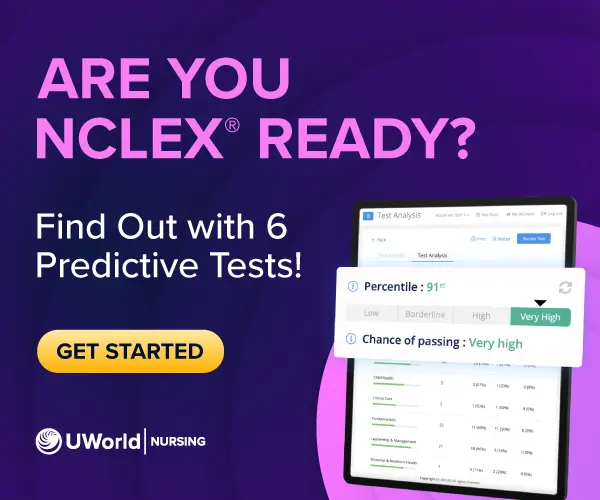About Next Generation NCLEX-RN® & NCLEX-PN® Exams

The National Council of State Boards of Nursing (NCSBN) administers the NCLEX to assess your eligibility for nursing licensure. The classic NCLEX was updated in April 2023 to the Next Generation NCLEX (NGN®), impacting the NCLEX-RN for registered nurses and the NCLEX-PN for practical or vocational nurses.
NCLEX Eligibility
Most nursing programs require you to have a degree from an accredited nursing program to take the NCLEX. Each state has unique eligibility requirements, so check with your state’s Board of Nursing for up-to-date information.
In the U.S., there are 2 versions of the exam: the NCLEX-RN and NCLEX-PN. Canadian nurses must take the NCLEX-RN.
| NCLEX-RN vs. NCLEX-PN | ||||
|---|---|---|---|---|
| Exam Type | License | Requirements | Test Fee | Test Site |
| NCLEX-RN | Registered Nurse | Diploma from RN licensure program or an Associate Degree of Nursing (ADN) or a Bachelor of Science in Nursing (BSN) |
$200 USD* $360 CAD** |
Pearson Vue Testing Center |
| NCLEX-PN | Licensed Practical Nurse or Licensed Vocational Nurse | Diploma or degree in practical nursing (LPN) or vocational nursing (LVN) | ||
*Additional fees for licensure are determined by the individual State Boards of Nursing.
**Excludes local taxes.
When to Take the NCLEX
Once your state nursing regulatory body (NRB) determines your eligibility to test, Pearson VUE will issue an Authorization to Test (ATT) via email. Your ATT is required to schedule an appointment to take the NCLEX. An ATT is typically valid for 90 days but may vary by jurisdiction.
You can typically take the NCLEX about 45 days after your graduation date, but you should check with your NRB for specifics. However, just because you can take the NCLEX during this period doesn't mean you should. You'll want to ask yourself these questions before you proceed:
- When do I plan to begin working as a nurse? Taking time off between graduation and the start of your career could give you extra time to study.
- How good is my memory? Taking the exam while the material is still fresh may be your preferred route.
- Am I prepared? Taking an extra few months to prepare for the NCLEX may make the difference in passing the exam on your first attempt.
Next Generation NCLEX Format and Structure
The Next Generation NCLEX was designed to better measure your clinical judgment. The test now includes new NGN item types and scoring methodology.
The NGN exam evaluates nursing knowledge and competencies through a structured test format that includes 8 Client Needs categories and various question types. Understanding the exam’s structure, content distribution, and scoring methods will help you effectively prepare and be successful.
NGN Tested Content
NGN content covers 8 Client Needs categories to ensure the exam covers a broad range of nursing competencies. The Client Needs categories are the same for the NCLEX-RN and NCLEX-PN in 6 of the 8 categories. They differ where indicated:
- Management of Care (Coordinated Care for PN)
- Safety and Infection Control
- Health Promotion and Maintenance
- Psychosocial Integrity
- Basic Care and Comfort
- Pharmacological and Parenteral Therapies (Pharmacological Therapies for PN)
- Reduction of Risk Potential
- Physiologic Adaptation
For a comprehensive overview of the content and its distribution on the NCLEX exams, visit our NCLEX-RN test plan and NCLEX-PN test plan.
NGN Question Types
The NGN exam includes 15 new question types to more accurately assess your knowledge and skills and better simulate real-world nursing scenarios. We have divided them into 3 categories to explain how to interpret them.
The first column includes “choose N” questions where you are told how many answer options to select. You are most likely familiar with multiple-choice or single-best-answer questions.
The questions in the second column require you to select as many correct answer options that are provided. These question types test your ability to distinguish relevant from irrelevant provided information.
The third column includes cloze questions. Think of these as fill-in-the-blank questions. You will be given a set of answer options and asked to select one or more that complete the sentence. You may be asked to select the best response from a drop-down list of answer options or boxes with answer options that can be dragged and dropped into the blank portion of the sentence.
| Choose “N” | Relevant vs Irrelevant | Justification |
|---|---|---|
|
|
|
You can still find these traditional question types on the exam:
- Single best response: Select 1 correct answer option
- Multiple-response: Select all correct answer options
- Fill-in-the-blank: calculation questions
- Hot spot: Identify 1 or more area(s) on a picture or graphic image
- Ordered response: Drag the correct answer to the correct box in the correct order
- Exhibits: Additional information provided to help answer traditional questions
- Audio/video: Listen to an audio/video clip to gather information and then select the correct answer option
New NGN Case Studies
In addition to new question types, the NGN also includes new case studies. The case studies assess your ability to apply nursing knowledge and critical thinking skills to complex, real-world scenarios.
On each exam, you will encounter 3 scored case studies, each featuring an evolving patient scenario that requires you to make clinical decisions based on the patient's needs. Each case study consists of 6 questions, for a total of 18 items. These questions follow an unfolding patient scenario, building sequentially to assess your clinical judgment skills. Case studies incorporate several of the new NGN question types including extended multiple response, extended drag-and-drop, and matrix/grid questions.
Pre-Test Questions
You will also receive 15 unscored questions as part of the exam for potential later use. These pre-test items look the same as scored questions, so give your best effort on every item.
Pre-test questions may include up to 2 additional unscored case studies and 1 or more NGN standalone clinical judgment questions within the first 85 exam questions.
NGN Length
You have up to 5 hours to complete the NGN. You can expect to receive a minimum of 85 and a maximum of 150 questions in that time. The number of scored questions ranges from 70 to 135.
You have about 2 minutes to answer each question and finish the exam. Recent results from NCSBN’s beta testing show that students spent about 1 minute on each question. You can take a break after 2 hours of testing and another after 3.5 hours. However, each break counts toward the 5-hour total time to test.
The computer will stop delivering new questions when the algorithm determines with 95% confidence that you have achieved competency. For example, the computer may determine that you've passed once you've answered the minimum 85 questions or could quiz you up to 150 questions. If you run out of time or complete the maximum number of questions within the 5 hours, the computer will determine whether you are above or below the passing point.
NGN Scoring
The NGN introduces polytomous, a new partial scoring method. You can now receive partial credit for correct responses on questions with more than 1 correct answer. The previous scoring method, dichotomous, has 2 possible outcomes: fully correct or fully incorrect.
The polytomous scoring method allows for a more accurate assessment of your abilities, as it considers the level of proficiency demonstrated by each response. This means that even if you did not provide a completely correct answer, you may still receive partial credit for demonstrating some level of proficiency.
New NGN Scoring Models
Here is a breakdown of the new scoring models:
0/1 Scoring Rule
Your answer is either correct or incorrect, earning you 1 point for a correct response and no points for an incorrect one. This scoring method is typically used for multiple-choice questions.
+/- Scoring Rule
You earn points for selecting correct options but lose points for selecting incorrect ones. Your score is calculated by adding points for correct answers and subtracting points for incorrect ones. If you select more incorrect options than correct ones, your lowest possible score will be 0.
Rationales Scoring Rule
The rationale scoring rule applies to questions that assess relational or paired information. To earn 1 point, both of your selected answers must be correct. If either or both are incorrect, your score for the question will be 0.
What is CAT?
Computerized Adaptive Testing (CAT) customizes your exam to match your ability level, making each test unique. An algorithm adjusts the difficulty of each question based on your response to the previous one.
You’ll start with a question near the passing level. If you answer correctly, the next question will be slightly harder. If you answer incorrectly, the next question will be easier. This process continues until a stopping rule determines whether you pass or fail.
Passing scores are governed by the following scenarios:
- Confidence Interval Rule: The computer ends the exam when it is 95% certain that your ability is clearly above or below the passing standard. This is the most common scenario.
- Maximum-Length Exam: If your ability is close to the passing standard, the computer will ask you the maximum number of questions before determining whether you pass or fail.
- Run-Out-of-Time Rule (ROOT): If you run out of time and haven’t answered the minimum number of questions, you will fail. However, if you’ve answered the minimum, the computer will decide whether you pass or fail based on your completed responses.
For more information about how each new question type is scored, visit our NCLEX Scoring Guide.
How Can I Start Studying for the NGN?
To begin your studying process, look for online study platforms that offer high-quality NGN-style practice questions, detailed answer rationales, and vivid visuals to help you build the clinical judgment skills needed for success.
Any NGN prep you choose to use should:
- Provide NGN case studies and clinical judgment questions to help you develop the critical thinking skills required for the new exam.
- Track performance data on all question types to give you insight into your learning progress and readiness.
- Ensure all content is updated to match the 2023 NCLEX-RN and NCLEX-PN Test Plans.
- Stay current with the latest NGN updates from the NCSBN through newsletters, conferences, and webinars.
Check out our NCLEX Study Plan for more tips and tricks to start studying.
Frequently Asked Questions (FAQs)
Read More About the NCLEX
NCLEX Eligibility, Registration & Cost
Learn more about the NCLEX registration process, eligibility, fees, and scheduling steps to help you prepare confidently and help you meet deadlines to avoid fee forfeitures.
See how the NCLEX is scored to help you better understand the testing process. Pass rates, result timelines, and retake policies are also covered.
Here’s everything you need to know about the NCLEX-RN. Discover exactly what to expect on exam day, what to bring, and how to study.
Here’s everything you need to know about the NCLEX-PN. Learn what to expect on exam day, what to bring, and how to prepare effectively.
Explore our complete roadmap for the NCLEX-RN, helping you understand how to organize your time leading up to exam day.
Dive into our thorough NCLEX-PN test plan. We provide clear insight on how to prepare for exam day, what resources to use, and what to expect.







